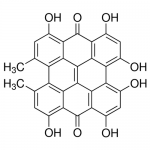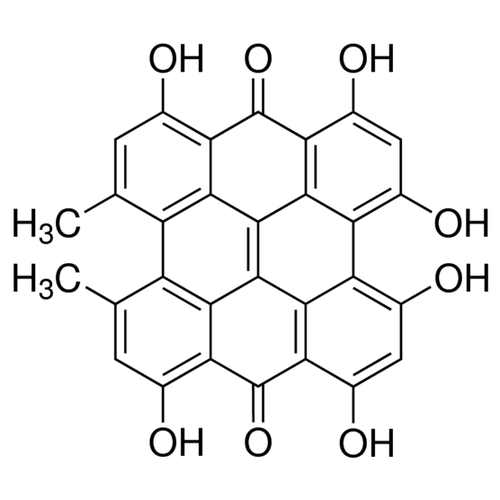| Product Name | Hypericin |
| Description |
Protein kinase C inhibitor |
| Purity | >98% |
| CAS No. | 548-04-9 |
| Molecular Formula | C30H16O8 |
| Molecular Weight | 504.45 |
| Field of Use | Not for use in humans. Not for use in diagnostics or therapeutics. For in vitro research use only. |
Properties
| Storage Temperature | -20ºC |
| Shipping Temperature | Shipped Ambient |
| Product Type | Inhibitor |
| Solubility | Soluble to 10 mM in ethanol and to 50 mM in DMSO |
| Source | Synthetic |
| Appearance | Dark Red Solid |
| SMILES | CC1=CC(=C2C3=C4C5=C(C(=CC(=C5C2=O)O)O)C6=C7C4=C8C(=C13)C(=CC(=C8C(=O)C7=C(C=C6O)O)O)C)O |
| InChI | InChI=1S/C30H16O8/c1-7-3-9(31)19-23-15(7)16-8(2)4-10(32)20-24(16)28-26-18(12(34)6-14(36)22(26)30(20)38)17-11(33)5-13(35)21(29(19)37)2 |
| InChIKey | BTXNYTINYBABQR-UHFFFAOYSA-N |
| Safety Phrases |
Classification: Harmful. May be harmful if inhaled, swallowed or absorbed through skin. Safety Phrases: S22 - Do not breathe dust S24/25 - Avoid contact with skin and eyes S36/37/39 - Wear suitable protective clothing, gloves and eye/face protection |
| Cite This Product | Hypericin (StressMarq Biosciences Inc., Victoria BC CANADA, Catalog # SIH-250) |
Biological Description
| Alternative Names | 1,3,4,6,8,13-Hexahydroxy-10,11-dimethylphenanthro[1,10,9,8-opqra]perylene-7,14-dione |
| Research Areas | Apoptosis, Cancer, Cancer Growth Inhibitors, Tyrosine Kinase Inhibitors |
| PubChem ID | 5281051 |
| Scientific Background | Hypericin is a naturally derived naphthodianthrone compound known for its antibiotic and kinase-inhibitory properties. It inhibits dopamine beta-hydroxylase, leading to elevated dopamine levels, which may influence mood and cognitive function. Hypericin's ability to accumulate in specific tissues, including tumors and potentially inflamed neural tissue, makes it a candidate for diagnostic imaging and targeted therapy. Its photosensitizing properties also enable its use in photodynamic therapy. In neuroscience, hypericin is being explored for its effects on neurotransmitter regulation and neuroinflammation. |
| References |
1. Hopfner M., et al. (2003) Int J Colorectal Dis. 18(3): 239-247. 2. Agostinis, et al. (2002) Int J Biochem Cell Biol. 34: 221. |



Reviews
There are no reviews yet.